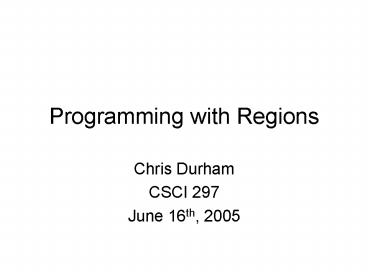Programming with Regions - PowerPoint PPT Presentation
Title:
Programming with Regions
Description:
Language Support for Regions, David Gay and Alex Aiken; UC Berkeley, 2001 ... All allocations of a particular type' allocated to same region' ... – PowerPoint PPT presentation
Number of Views:23
Avg rating:3.0/5.0
Title: Programming with Regions
1
Programming with Regions
- Chris Durham
- CSCI 297
- June 16th, 2005
2
Paper
- Language Support for Regions, David Gay and Alex
Aiken UC Berkeley, 2001
3
Memory Management Issues
- Allocation / Deallocation mismatch
- malloc() / free()
- Dereference dangling pointers
- Heap fragmentation, boundary issues
- Sizing, when to allocate
- Remembering to free() !
4
Garbage Collection Questions
- When to scan?
- How often?
- Rearranging?
- Paper states that they did some work with gcc
and the Boehm-Weiser garbage collector
5
Regions
- Concept to address some of these issues
- All allocations of a particular type allocated
to same region - Reference count kept to the region
- Can only deallocate region after no references
exist deallocates all objects within the
region - Best used for complex data structures
6
Example (1)
reference count 1
7
Example (2)
reference count 2
8
Example (3)
reference count 2
9
Region Benefits
- Region can only be de-allocated when reference
count 0 attempts abort program when checking
enabled - Rely on region library to optimize heap usage and
make garbage collection easier - presumably,
implementation of regions is well structured and
uses knowledge of allocator - Programmer doesnt necessarily have to focus on
memory management to same degree as with
traditional malloc()/free() - In some ways, this concept is similar to resource
pooling as in Apache, but is unstructured
10
RC Compiler
- A library and compiler (rcc), compiles annotated
code to C code. Introduces several annotations - http//www.cs.berkeley.edu/dgay/rc
- Also
- Cyclone has its own region sub-system
11
Code snippet
- struct rlist struct rlist sameregion next
- struct finfo sameregion data
- rl, last NULL
- region r newregion()
- while ()
- rl ralloc(r,struct rlist)
- rl-gtdata ralloc(r,struct rlist)
- / fill in data /
- rl-gtnext last last rl
- output_rlist(last)
- deleteregion(r)
12
Pointer annotations et al
- sameregion in same region
- traditional not in a region at all
- parentptr you can have sub-regions, this means
this pointer exists in the region one level
higher - struct Foo sameregion foo
- struct Bar traditional bar
- struct Parent parentptr parent
- struct region has a member rc for reference
count - regionof() to determine what region an identifier
is in - Also a constraint inference system that proves
some type safety situations was built into rcc,
enables them to remove some runtime checks that
verify the type constraints to speed things up
13
Results
14
Conclusions
- Regions can help make memory management easier
by eliminating the need for the programmer to
concentrate on some memory management issues and
it even speeds up things a bit over traditional
methods - As we discussed previously, benchmarks and real
life are two different things - - no real test of the robustness of the region
library itself
15
Original Problems? / New Problems
- Of the original problems, which ones do regions
address? - What new challenges are there for the
programmer? - What are the security implications here?
16
References
- Language Support for Regions David Gay and Alex
Aiken UC Berkeley, 2001 - Region-Based Memory Mapping in Cyclone, Dan
Grossman, Greg Morrisett, Trevor Jim, Michael
Hicks, Yanling Wang, James Cheney Cornell
University 2002































